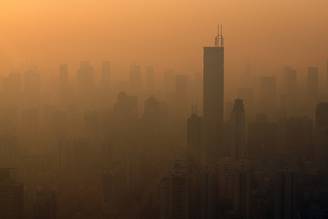

http://www.flickr.com/photos/31991270@N02/3239978519/
The impacts of Industrialization:
The case of Shenzhen


http://www.flickr.com/photos/31991270@N02/3239978519/
China is one of those developing countries that have most recently gone through the process of industrialization, and thereby changing from a societal focused on agricultural production into secondary industrial production. This change brought tremendous wealth and empowerment to the Chinese people, allowing China to become the second largest economy in the world. However, this rapid progression did not come without a social cost, industrialization has caused great destruction to the natural environment of the industralizing regions, causing social problems such as untreated chemical sewage to skyrocketing green house gases. Shenzhen, now one of the largest metropolitan areas in China, is a perfect example to show the environmental costs that industrialization brings to a local region.
As part of the ‘Open Door’ economic reforms of 1979, Deng Xiaoping set up 5 special economics zones (SEZ) to encourage foreign investment and foreign-funded industrialization in China; Shezhen was amongst the five regions chosen. Before this, Shenzhen was only a small fishing village with a small local population. The speed of industrialization increased continuously throughout the 80s, especially after the industrial flight started in Hong Kong as producers began to move their production units to the mainland. As of 2007, this small fishing village has already become a large metropolitan area with a population of 8 million. The population density is 4400 persons/ sq mile. Much of the original landscape have since been altered to make way for silver skyscrapers and apartment buildings. The government tax incentives such as rebates and low export taxes lored factory owners from nearby regions, while relaxed environmental requirements further reduced production costs. Now, Shenzhen is also one of the most polluted urban cities in the world, showing the world yet another example the negative effects of industrialization.
Due to all the production activities occurring in the Shenzhen area, air pollution levels have reached levels never seen before. Due to lack of funding and governmental regulation, a lot of the factories are not required to process their production byproducts. The production industry is not the only major source of carbon emissions; private vehicles are also amongst the major contributors to the city’s high level of carbon emissions. Chemicals that are released into the air during production also form irritating smog days that pose serious threat to human health. In the year 2003 only, the city had 131 days of smoggy days, the most in fifty years. Throughout the 1970s, the amount of hazy days total to 8 days compared to 773 days in the 1990s (Daily). Another major contributor to Shenzhen’s deteriorating air quality are the surrounding coal powerplants that Shenzhen and nearby cities (such as Hong Kong) depend on for maintaining their enormous population. Due to lack of technology and financing, most of the coal power plants lack the equipment to remove smaller particles such as sulphur dioxide, which merge with H2O particles in the atmosphere and create acid rain.

http://www.zonaeuropa.com/20070826_1.htm
Shenzhen is notorious for it’s black acid rain, which burns through car paint and is very damaging to the human skin. As the need for electricity continues to increase due to the demands from the growing populations in cities, coal power plants will forever pose a serious environmental threat to Shenzhen and its surrounding area.
Another major source of pollution that industrialization brought was water pollution, consisting of both untreated waste from the industrial sector and also water usage by the 8 million people that reside in the Shenzhen. The industrial focus of Shenzhen during the 1980s throughout 90s, were focused more on the light and processing production and textile industries. As these industrial sectors grew, the government implemented very little regulations on the treatment of production waste. As a result, a lot of the factories did not invest in waste treatment utilities, and directly dumped their production wastes into nearby streams. These streams eventually lead into the Pearl River Delta, once filled with freshwater fish, has now become notoriously famous for its poor water quality. This poses an immediate threat as the Pearl Delta not only provides river transport for importing and exporting goods from the coast into the main lands, but is also a major source of fresh water for the surrounding urban areas. There has already been a noticeable deterioration in the quality of tap water since the 1990s, and the government finally began to implement better wastewater treatment utilities, water quality monitoring systems to improve the pollution levels (Huang, P259).
Just like other large cities such asTokyo and New York City, the administrators of the Shenzhen provincial government have become increasingly aware of the pollution problems that industrialization has left behind. They are working hard to prevent the environmental disasters Tokyo had during its industrialization process, which made Tokyo one of the most polluted cities in the early 90s. Since then, the Tokyo metropolitan government had worked hard to lower green house emission and reduce various sources of pollution. Beginning with the initiative to clean up the Pearl Delta River, the Shenzhen provincial government and the Guangdong Provincial government also implemented new regulations on greenhouse emissions. Accompanying these new regulations is the shift in developmental focus, from the previous light-and-processing industries into high-tech industries that have lower demans on labor and produces relatively lesser pollutants. Along with the transition into the high tech industries, the Shenzhen governments also directed their other focus on developing the servicing industry. Despite the provincial governments attempt to shift developmental focus away from the production industry, the administrators must also confront new environmental issuses, such as Tokyo’s ‘heating island’ problem. From the current path of development, we can see the Shenzhen is following the exact paths of Tokyo and other cities in the developed world.
Shenzhen’s industrial development process can also be explained with the Kuznets Curve, which states that,
“In the first stage of industrialization, pollution in the environmental Kuznets curve world grows rapidly because people are more interested in jobs and income than clean air and water, communities are too poor to pay for abatement, and environmental regulation is correspondingly weak. The balance shifts as income rises." (Pattni)
This curve predicts that around the $5000 to $8000 per capita range, both air and water pollution levels will start to even out and decrease as income continues to rise. As of 2007, the GPD per capita for Shenzhen reached $13,590. There are already signs showing an industrial flight from Shenzhen into nearby regions deeper into the mainland as the government shifts aways from primary and secondary production industries; Shenzhen will soon enter the last stage of its industrialization process.
The development of the Shenzhen metropolitan area exemplifies the negative impacts that industrialization has on the environment, however it also shows us the resources that a developing region needs to prevent similar environmental disasters. As the city becomes more environmentally aware, the growth-focused developmental prospective will soon change to focus on to sustainability and millions of dollars will be spent on cleaning up the pollution that industrialization producted. Developing regions all over the world need the technical and financial support of developed countries to assist them in achieving economic growth with lighter consequences to the environment, by assisting others in becoming more environmental conscious these developed countries can begin to compensate the world for the pollution that they have already left behind.
![]()
![]()
Works Cited
Send message to Swarthmore College Environmental Studies
last updated 1/25/10
webmaster